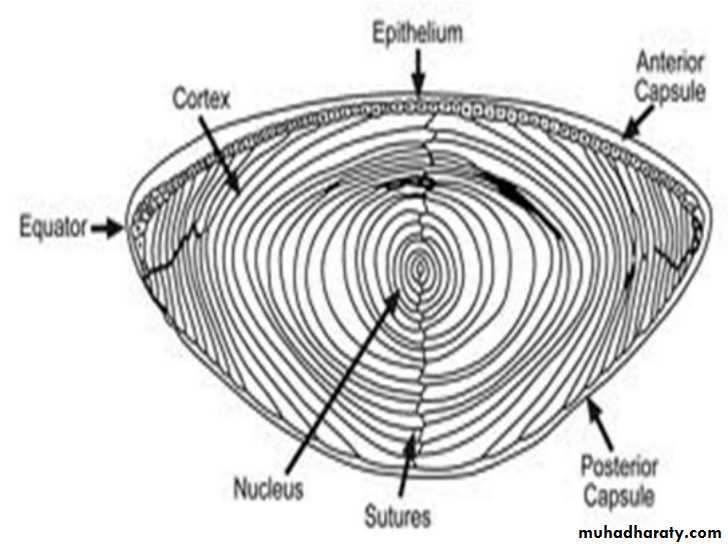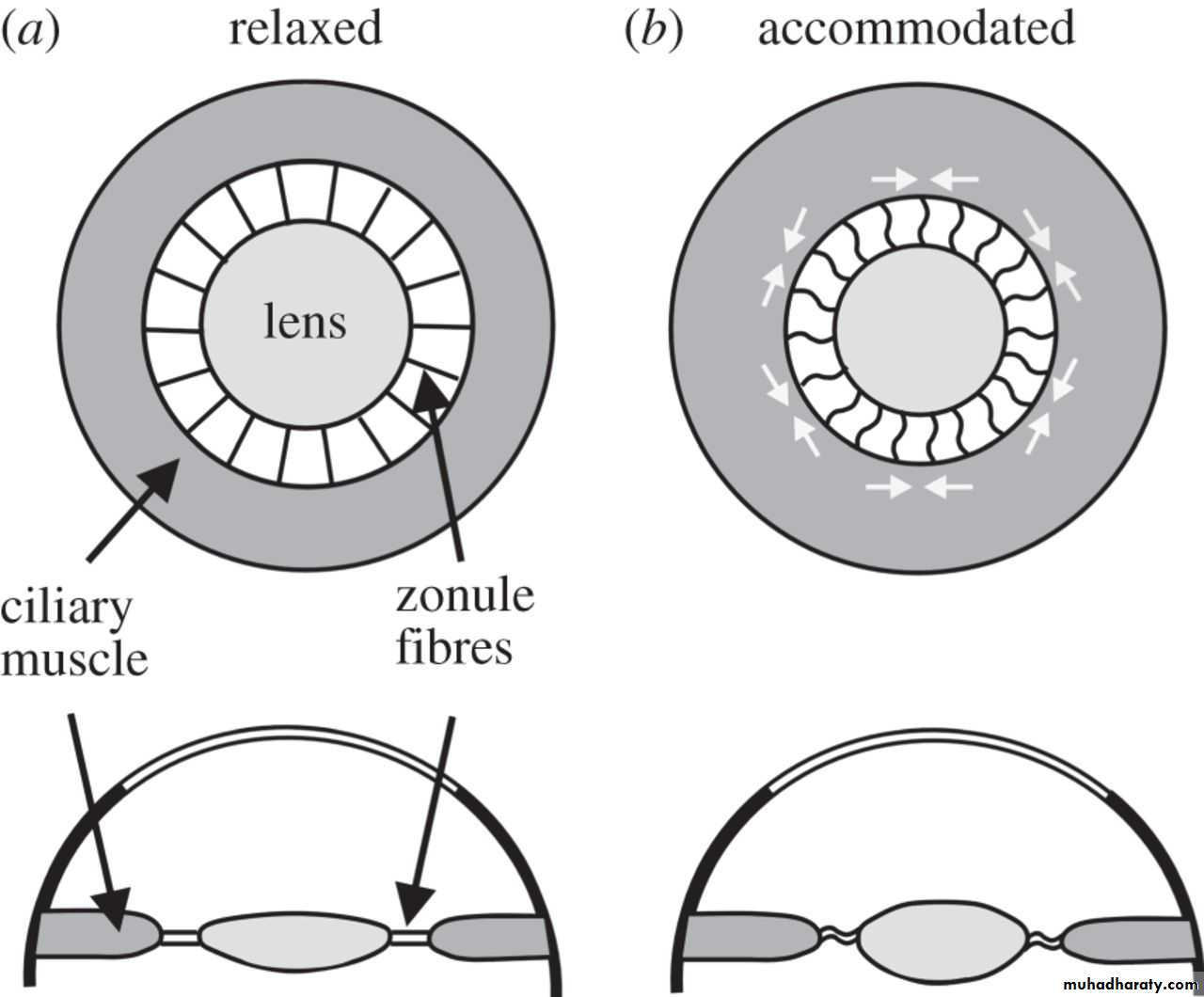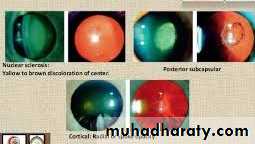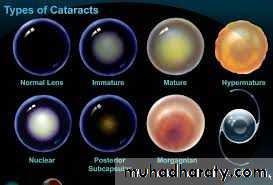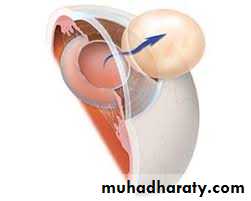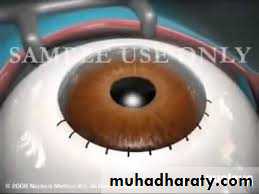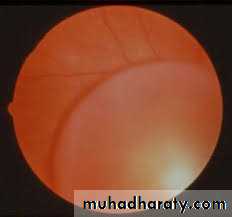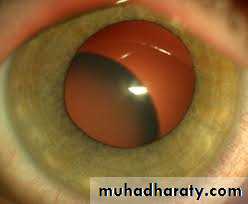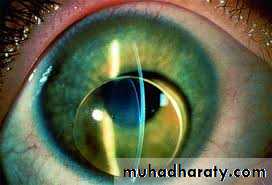crystalline lens
Anatomy of the lens
The crystalline lens is a biconvex, avascular transparent structure enclosed by a capsule.The lens consists of:
1- Nucleus:
2- Cortex:
3- The capsule:
What is zonules?
What is "Accommodation"
-The lens grows in both anteroposterior and equatorial dimensions throughout life (this explains why angle- closure glaucoma occurs in old aged people, as the increasing volume of the lens may cause blockage or closure of the angle and impair drainage of fluid from anterior chamber to trabecular meshwork
Symptoms and signs of diseases of lens:
1- Cataract:
2- Presbyopia:
3- Nuclear sclerosis:
4- Monocular diplopia:
Cataract
What is cataract?Types of cataract:
1- According to its site within the lens:
posterior subcapsular,
anterior subcapsular,
nuclear, and
cortical
2- According to maturation:
Immature:Mature:
Hypermature Cataract:
Intumescent Cataract (phacomorphic cataract):
3- According to its onset:
either acquired or congenital.Acquired cataract
1- Age-related cataract:2- Pre-senile cataract: develops before the age of 60 in the following conditions:
a- Diabetes Mellitus:
b- Myotonic dystrophy: 90% of patients develop cataract in the third decade.
c- Atopic dermatitis: 10% of patients with severe atopic dermatitis develop cataract in the 2nd-4th decades of life.
d- Neurofibromatosis type 2.
3- Traumatic cataract: trauma is the most common cause of unilateral cataract in young individuals:
4- Drug-induced cataract:
a- Steroids: both systemic and topical steroids are cataractogenic.
b- Chlorpromazine:: both corneal and lenticular deposits are dose related and usually irreversible
c- Amiodarone (anti-arrhythmic): lens deposits occur in 50% of patients
d- Gold: lens deposits occur in 50% of patients on treatment for longer than 3 years
e- Allopurinol:
Treatment of catract:
SURGERY● there is NO effective medical treatmentIndications of surgery:
1- Visual improvement:is the most common indication, whether it is mature or immature.
2- Medical indications:
2- Medical indications:
Types of cataract surgery:1- Intracapsular cataract extraction (ICCE) ± AC IOL (anterior chamber, intraocular lens):
2- Extracapsular cataract extraction (ECCE) ± PC IOL (posterior chamber intraocular lens):
3- Phacoemulsification:
Aphakia: absence of the lens from the eye, or its absence from the pupillary area (luxated). An aphakic eye is usually strongly hypermetropic where parallel rays of light are brought to a focus behind the retina. Usually acquired and rarely congenital.
Treatment:
1- High powered convex lenses in spectacles: what is anisoconia?
2- Contact lens (1% magnification):
3- IOL (intraocular lens): is the best way of correction as there is no magnification at all.
Congenital cataract:
Occurs in about 3:10.000 live birth, 2/3rd of cases are bilateral.Causes:
1- Isolated hereditary cataracts: Account for about 25% of cases, mode of inheritance is most frequently AD (Autosomal dominant), yet AR (Autosomal Recessive) and X-linked inheritance can occur.
2- Metabolic cataract:
a- galactosaemia (Galactose -1-phosphate uridyl transferase "GPUT").
b- Lowe's (oculocerebral) syndrome: rare inborn error of amino acid metabolism which predominantly affects boys (X-linked).
3- Prenatal infections:
a- Congenital Rubella: cataract presents in 15% of cases.
b- Others: Cytomegalovirus, Herpes simplex and Varicella
4- Chromosomal abnormalities:
a- Down syndrome (Triosomy 21).
b- Other: Patau syndrome (Triosomy 13), Edward syndrome
Treatment:
Assessment ?Surgery is by lensectomy (removal of the entire cataractous lens) + anterior vitrectomy (removal of anterior surface of the vitreous just posterior to the lens) should be done with it as opacification of anterior vitreous face occur in 100% of childs after surgery.
Correction of aphakia in congenital cataract:
1- Unilateral aphakia: either IOL or contact lens (NO role for glasses)
2- Bilateral aphakia: in addition to IOL and contact lens, it can be corrected by spectacles.
Ectopia lentis
Is refers to a displacement of the lens from its normal position. The lens may be completely dislocated "Luxated" (complete destruction or cut of zonules) or partially dislocated "Subluxated".Causes:
- Trauma.
- Large eye {high myopia, buphthalmus (congenital glaucoma)} , due to stretching of zonules that causes their destruction.
- Anterior uveal tumour, as it pushes the lens away from the ciliary body leading to destruction of zonules.
2- Congenital:
a- Without systemic association: AD, AR or associated with aniridia (congenital absence of iris).
b-With systemic association: e.g., Marfan's syndrome, Weill-Marchesani syndrome, homocystinuria, Ehlers-Danlos syndrome.
Complications of ectopia lentis:
1- Refractive errors: myopia (as the lens moves forward) and astigmatism (as the lens is tilted).
2- Glaucoma:
3- Endothelial touch:
4- Lens induced uveitis:
Indications of treatment:
1- Refractive error: treated by spectacles and surgery if not corrected by spectacles.2- Glaucoma: - If the lens is clear, so we do YAG PI (Yttrium-Aluminum-Garnet Peripheral Iridotomy,
If there is cataract, we do lens extraction.
3- Endothelial touch removal of lens.
4- Lens induced uveitis (which is chronic) removal of lens.

